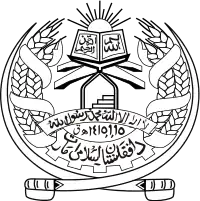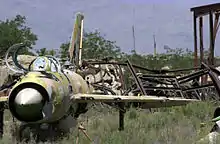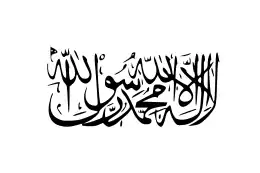Islamic Defence Force of Afghanistan
The Islamic Defence Force of Afghanistan was the army and air force of the Islamic Emirate of Afghanistan.
| Islamic Defence Force of Afghanistan | |
|---|---|
| قوة الدفاع الإسلامية في أفغانستان | |
 Flag of the Islamic Emirate of Afghanistan | |
| Founded | 1997 |
| Disbanded | 2001 |
| Service branches | Afghan National Army Corps Afghan National Air Corps |
| Headquarters | Kabul |
| Manpower | |
| Military age | 15 |
| Conscription | Yes |
| Reaching military age annually | 200,000 (1998) |
| Active personnel | 400.000 |
| Reserve personnel | 15,000 |
| Industry | |
| Foreign suppliers | |
Army
The Afghan Army was effectively disbanded after the Taliban took control of Afghanistan. The Taliban maintained 400 T-54/55 and T-62 tanks and more than 200 armoured personnel carriers.[1][2] The Taliban also began training its own army and commanders, some of whom were secretly trained by the Pakistan Inter-Services Intelligence and Pakistani Armed Forces around the Durand Line. After the removal of the Taliban government in late 2001, private armies loyal to warlords gained more and more influence. In mid-2001, Ali Ahmed Jalali wrote:[3]
The army (as a state institution, organized, armed, and commanded by the state) does not exist in Afghanistan today. Neither the Taliban-led "Islamic Emirate of Afghanistan" nor the "Islamic State of Afghanistan" headed by the ousted President Rabbani has the political legitimacy or administrative efficiency of a state. The militia formations they command are composed of odd assortments of armed groups with varying level of loyalties, political commitment, professional skills, and organizational integrity. Many of them feel free to switch sides, shift loyalties, and join or leave the group spontaneously. The country suffers from the absence of a top political layer capable of controlling individual and group violence. ... Although both sides identify their units with military formations of the old regime, there is hardly any organizational or professional continuity from the past. But these units really exist in name only ... in fact only their military bases still exist, accommodating and supporting an assortment of militia groups.
Air Force
The Afghan Air Force under the Taliban maintained five supersonic MiG-21MFs and 10 Sukhoi-22 fighter-bombers.[4] In 1995, during the 1995 Airstan incident, a Taliban fighter plane captured a Russian transport. They also held six Mil Mi-8 helicopters, five Mi-35s, five L-39Cs, six An-12s, 25 An-26s, a dozen An-24 and An-32s, an IL-18, and a Yakovlev.[5] Their civil air service contained two Boeing 727A/Bs, a Tu-154, five An-24s, and a DHC-6.[5]
The Afghan Air Force under the Taliban did not see action in the Afghan Civil War and almost all aircraft were destroyed by the US in the War in Afghanistan (2001–present). Most of the MiG-21 fleet met their end in an Afghan junkyard. The roundel of most of the aircraft was a washed over DRAAF Roundel with the green paint of the Taliban.[6][7]
On 3 August 1995 a Taliban Air Force MiG-21 aircraft forced the Russian aircraft to land at Kandahar.[8][9] Negotiations between the Russian government and the Taliban to free the men stalled for over a year and efforts by American senator Hank Brown to mediate between the two parties broke down over a prisoner exchange.[10] The Taliban stated that they would free the airmen if the Russians released Afghans held by the Russian government. However the Russians denied holding any Afghan citizens. Brown was able to get the Taliban to agree that the Russian crew should be allowed to maintain their aircraft.[10] This request paved the way for their escape.[10]

Taliban Civil Aviation Service
After the end of the Soviet war in 1989 and collapse of Najibullah's government, the Taliban took over Kabul in 1996. Afghanistan faced substantial economic sanctions from the international sector during the Taliban regime. The sanctions, along with the Taliban government's control of Ariana Afghan Airlines and the grounding of many of the carrier's international flights, had a devastating effect on the economic health of the company through the 1990s. The fleet was reduced to only a handful of Russian and Ukrainian built An-26s, Yakovlev Yak-40s and three Boeing 727s, which were used on the longest domestic routes and military transport roles. In October 1996, Pakistan provided a temporary maintenance and operational base at Karachi. With no overseas assets, by 1999 Ariana's international operations consisted of flights to Dubai only; also, limited cargo flights continued into China's western provinces. However, sanctions imposed by UN Security Council Resolution 1267 forced the airline to suspend overseas operations. In November 2001, Ariana was grounded completely.
According to the Los Angeles Times:
With the Taliban's blessing, Bin Laden effectively had hijacked Ariana, the national civilian airline of Afghanistan. For four years, according to former U.S. aides and exiled Afghan officials, Ariana's passenger and charter flights ferried Islamic militants, arms, cash and opium through the United Arab Emirates and Pakistan. Members of Bin Laden's Al Qaeda terrorist network were provided false Ariana identification that gave them free run of airports in the Middle East.
According to people interviewed by the Los Angeles Times, Viktor Bout's companies helped in running the airline.[11]
Conscription
According to the testimony of Guantanamo captives before their Combatant Status Review Tribunals, the Taliban, in addition to conscripting men to serve as soldiers, also conscripted men to staff its civil service.[12]
Kidnapping foreigners
Prior to the collapse of their regime the Taliban made widespread use of conscription, and according to some of the Guantanamo captives, kidnapping and virtual slavery.
Conscription of children
According to a report from Oxford University the Taliban made widespread use of the conscription of children in 1997, 1998 and 1999.[13] The report states that during the civil war that preceded the Taliban regime, thousands of orphaned boys joined various militia for "employment, food, shelter, protection and economic opportunity." The report said that during its initial period the Taliban "long depended upon cohorts of youth". Witnesses stated that each land-owning family had to provide one young man and $500 in expenses. In August of that year 5000 students aged between 15 and 35 left madrassas in Pakistan to join the Taliban.
References
- Stars and Stripes (15 July 2014), The Beasts of Kabul: Inside the Afghan Army's Soviet Tanks, retrieved 5 July 2018
- The Guardian, Taliban lose grip on Mazar i Sharif, 7 November 2001
- Ali A. Jalali, Afghanistan: The Anatomy of an Ongoing Conflict Archived 2016-12-10 at the Wayback Machine, Parameters, Spring 2001, pp. 85–98.
- York, Geoffrey. The Globe and Mail, "Military Targets Are Elusive. Afghanistan Army Called a Haphazard Operation", 19 September 2001
- Jane's Sentinel Security Assessment, 2001
- Ivanov, Grigory. "WINGS PALETTE – MiG MiG-21/J-7 Fishbed/Mongol – Afghanistan (Taliban)". wp.scn.ru. Retrieved 5 July 2018.
- Little is known about the Taliban regime's air force establishment.
- Russian airmen escape from Afghanistan, Phil Reeves, The Independent, 19 August 1996
- Farah & Braun 2007, p. 60
- Associated Press 1996, p. 4
- "On the Trail of a Man Behind Taliban's Air Fleet". Los Angeles Times. 19 May 2002. Archived from the original on 11 August 2014.
- Dixon, Robyn (13 October 2001). "Afghans in Kabul Flee Taliban, Not U.S. Raids". Los Angeles Times. Retrieved 11 December 2012.
- Jo Boyden, Jo de Berry, Thomas Feeny, Jason Hart (January 2002). "Children Affected by Armed Conflict in South Asia: A review of trends and issues identified through secondary research" (PDF). University of Oxford Refugee Studies Centre. Archived from the original (PDF) on 28 July 2007. Retrieved 5 January 2008.CS1 maint: multiple names: authors list (link)
